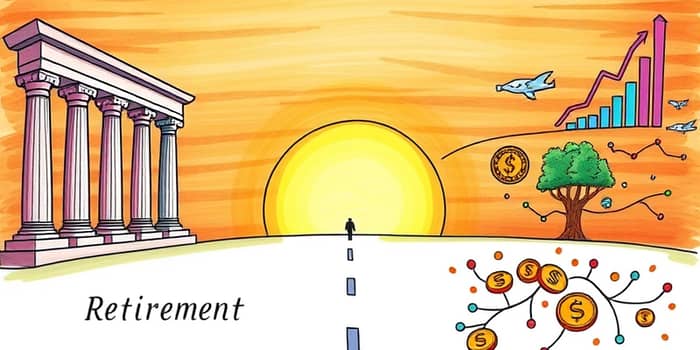
Retirement planning often presents a critical choice between traditional pensions and modern 401(k) plans. Each option offers unique features, risks, and benefits that can shape the financial security of your golden years. By unpacking the structure, tax treatment, portability, and risk factors associated with each plan, you can craft an informed strategy for a comfortable retirement.
Navigating the retirement landscape requires clarity on how these vehicles differ and complement each other. This article delivers a thorough comparison, expert insights, and practical guidance to help you align your savings approach with your long-term goals.
A pension, also known as a defined benefit plan, is an employer-sponsored retirement arrangement that promises a set monthly income based on years of service and salary history. Employers bear the responsibility of funding and managing the plan.
A 401(k), classified as a defined contribution plan, allows employees to contribute pre-tax dollars from each paycheck. The ultimate value at retirement depends on individual contributions and investment performance.
Pensions are built on an employer-funded guarantee of retirement income. Companies pool resources, hire professional managers, and promise retirees a fixed benefit. This employer bears the investment performance risk, shielding employees from market volatility.
By contrast, 401(k) participants enjoy control over investments and flexible contributions. Employees direct funds into mutual funds, stocks, or bonds. However, this also means employee bears the investment performance risk, making market downturns a direct threat to retirement balances.
Pension plans typically disburse a defined monthly benefit for life, sometimes including survivor options for spouses. Some pensions offer a one-time lump-sum payout, transferring risk to retirees and requiring careful withdrawal strategies.
401(k) accounts allow penalty-free distributions starting at age 59½. Retirees choose periodic withdrawals or lump sums. Without guaranteed income, individuals must adopt strategies to avoid outliving your savings and manage withdrawal rates prudently.
Pensions often impose vesting schedules that delay full ownership. Leaving an employer prematurely can reduce or forfeit benefits, making pensions not easily portable between jobs. In contrast, 401(k) plans can be rolled into IRAs or new employer plans, offering rolling balances seamlessly into an IRA.
Both pensions and 401(k)s enjoy tax advantages. Pension payouts and 401(k) withdrawals are taxed as ordinary income. 401(k) contributions are tax-deferred contributions boosting growth over time, lowering current taxable income and allowing investments to compound.
Relying on a single retirement vehicle can leave gaps in income security or expose you to undue market risk. Many experts recommend blending a pension (if available) with a 401(k) and individual retirement accounts (IRAs). This diversifies income sources and manages tax liability across different stages of retirement.
Key considerations include understanding vesting schedules, maximizing employer matching contributions, and aligning withdrawal tactics with lifespan projections. Enlisting the help of a trusted financial advisor can refine contribution levels, optimize asset allocation, and develop withdrawal plans that suit your goals.
Pensions are becoming increasingly rare in the private sector, while 401(k)s dominate new retirement offerings. Some legacy employers and public agencies still maintain both options, creating opportunities to leverage the strengths of each plan.
As retirement landscapes evolve, staying informed on regulatory changes, contribution limits, and catch-up opportunities for those over 50 is vital. Proactive planning, ongoing education, and periodic portfolio reviews will ensure you remain on track to enjoy a dignified and financially secure retirement.
References













